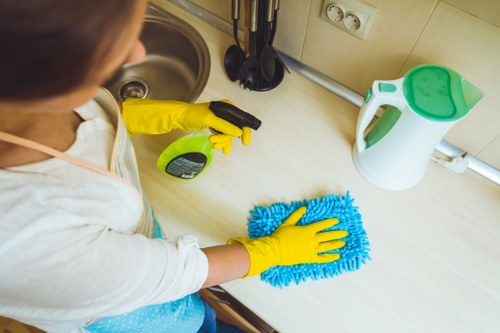Ultimate Guide to Oven Cleaning with Whetstone

Cleaning your oven can be a daunting task, but with the right tools and techniques, it becomes manageable and even satisfying. One such tool that has gained popularity is the whetstone. While traditionally used for sharpening knives, a whetstone can be surprisingly effective in oven cleaning.
In this article, we will explore the benefits of using a whetstone for oven cleaning, provide a step-by-step guide on how to use it, and discuss its advantages over traditional cleaning methods. Whether you're dealing with stubborn grease or looking for an eco-friendly cleaning solution, a whetstone might just be the tool you need.
Let's dive into the world of oven cleaning with a whetstone and discover how this versatile tool can make your kitchen maintenance easier and more efficient.

Why Choose a Whetstone for Oven Cleaning?
Whetstones are known for their durability and effectiveness in sharpening blades, but their application doesn't stop there. Using a whetstone for oven cleaning offers several benefits:
- Eco-Friendly: Whetstones are a sustainable option, reducing the need for harsh chemical cleaners.
- Cost-Effective: Once you invest in a good whetstone, it can be used repeatedly without additional costs.
- Non-Toxic: Ideal for households with children and pets, as it avoids harmful chemical residues.
- Versatile: Can be used for various cleaning tasks beyond the oven, such as stovetops and grill grates.
These advantages make the whetstone an appealing choice for those seeking an effective and environmentally friendly cleaning method.

Preparing Your Oven for Cleaning
Before you start cleaning your oven with a whetstone, proper preparation is essential to ensure safety and effectiveness.
Safety First
Always unplug the oven and ensure it is completely cool before beginning the cleaning process. This prevents any risk of electrical hazards or burns.
Remove Oven Racks
Take out the oven racks and set them aside. These can be cleaned separately using the whetstone or other appropriate cleaning tools.
Initial Debris Removal
Use a damp cloth or sponge to wipe out any loose debris or food particles from inside the oven. This makes the smoothing process with the whetstone more effective.

Step-by-Step Guide to Using a Whetstone for Oven Cleaning
Step 1: Wet the Whetstone
Start by soaking your whetstone in water for about 10-15 minutes. A wet whetstone helps in effectively breaking down grime without scratching the oven surfaces.
Step 2: Apply Gentle Pressure
Using the flat side of the whetstone, gently scrub the oven walls and bottom. Apply moderate pressure to lift off stubborn grease and burnt-on food.
Step 3: Focus on Problem Areas
Pay extra attention to areas with heavy buildup. Use circular motions to ensure thorough cleaning. The abrasive surface of the whetstone aids in breaking down tough grime.
Step 4: Rinse and Wipe
After scrubbing, rinse the whetstone and wipe the oven with a clean, damp cloth to remove any residue. Repeat the process if necessary for particularly stubborn spots.
Step 5: Clean the Oven Racks
Use the whetstone to scrub the oven racks. Their flat surfaces make them ideal candidates for whetstone cleaning, ensuring they are free from grease and food particles.
Step 6: Final Inspection
Once you've cleaned all areas, inspect the oven to ensure it's spotless. Replace the racks and plug the oven back in, ready for your next culinary adventure.

Advantages Over Traditional Cleaning Methods
Using a whetstone for oven cleaning offers several advantages compared to conventional methods:
- Less Chemical Use: Reduces the reliance on chemical cleaners, fostering a healthier home environment.
- Enhanced Durability: Whetstones are long-lasting and can handle repetitive cleaning tasks without wearing down quickly.
- Precision Cleaning: Allows for targeted cleaning, reaching into small crevices and corners that might be challenging with other tools.
- Environmentally Friendly: Being reusable and free from chemicals, whetstones have a minimal environmental impact.
These benefits make whetstones not only a practical choice but also a responsible one for sustainable home maintenance.
Maintenance Tips for Your Whetstone
To ensure your whetstone remains effective for oven cleaning, follow these maintenance tips:
- Clean After Use: Rinse the whetstone thoroughly with water after each use to remove any residue.
- Dry Properly: Allow the whetstone to air dry completely to prevent mold and mildew buildup.
- Store Correctly: Keep the whetstone in a dry, cool place to maintain its integrity.
- Avoid Harsh Chemicals: Do not use strong detergents or abrasive cleaners on the whetstone, as this can damage its surface.
- Regular Inspection: Check for any signs of wear or damage regularly and replace the whetstone if necessary.
Local Services in and Around Whetstone
If you prefer professional assistance, there are several local areas near Whetstone that offer exceptional oven cleaning services. Here's a list of nearby areas you might consider:
- Harlesden: Just 2 miles from Whetstone, Harlesden offers eco-friendly oven cleaning specialists.
- Kensal Green: Located 3 miles away, known for its thorough and affordable cleaning services.
- Cricklewood: A 4-mile distance with experts in using natural cleaning agents.
- Northern Heights: 5 miles from Whetstone, offering quick and efficient oven cleaning solutions.
- Stonebury: Situated 6 miles away, renowned for its reliable and professional cleaners.
- Harmondsworth: 7 miles from Whetstone, providing specialized services for stubborn oven grime.
- Neasden: At 8 miles, offering both residential and commercial oven cleaning.
- Willesden Junction: 9 miles away, known for their attention to detail in oven maintenance.
- West Hendon: 10 miles from Whetstone, providing comprehensive kitchen cleaning services.
- Queen’s Park: 11 miles away, offering eco-friendly and efficient oven cleaning.
- Alperton: 12 miles from Whetstone, trusted for their professional and courteous service.
- Sudbury: 13 miles away, known for using advanced cleaning techniques.
- Park Royal: 14 miles from Whetstone, offering competitive pricing for oven cleaning.
- Willesden Green: 15 miles away, providing personalized cleaning plans to suit your needs.
Conclusion
Cleaning your oven with a whetstone is an innovative and effective method that combines sustainability with efficiency. By following the steps outlined in this guide, you can achieve a spotless oven without relying on harsh chemicals. Additionally, understanding the benefits and maintenance of your whetstone ensures it remains a valuable tool in your household.
Whether you choose to tackle the cleaning yourself or opt for professional services in the nearby areas of Whetstone, maintaining a clean oven is crucial for both hygiene and the longevity of your appliance. Embrace the power of the whetstone and transform your kitchen cleaning routine today.
Frequently Asked Questions
1. Can I use a whetstone on all types of ovens?
Yes, a whetstone is generally safe to use on most oven types, including electric and gas ovens. However, always check your oven’s manual for specific cleaning recommendations.
2. How often should I clean my oven with a whetstone?
For optimal maintenance, it’s recommended to clean your oven with a whetstone every 3-6 months, depending on usage frequency and the amount of residue buildup.
3. Is a whetstone effective on stainless steel ovens?
Absolutely. Whetstones are effective in removing stubborn stains and grease from stainless steel surfaces without scratching them when used correctly.
4. Do I need to lubricate the whetstone after cleaning?
No lubrication is necessary. Simply rinse the whetstone with water, dry it thoroughly, and store it in a dry place.
5. Can I use the whetstone for other kitchen cleaning tasks?
Yes, beyond ovens, a whetstone can be used to clean stovetops, grill grates, and even certain cookware surfaces, making it a versatile tool in your kitchen.

